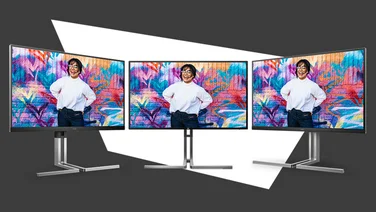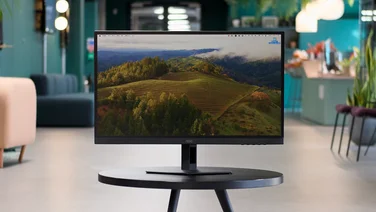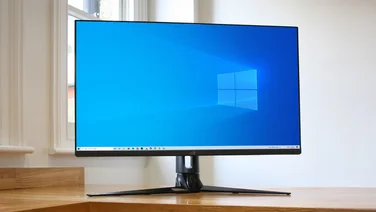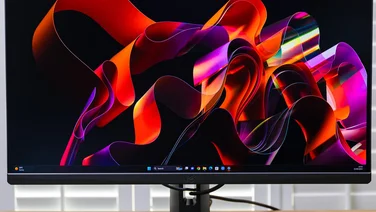To help us provide you with free impartial advice, we may earn a commission if you buy through links on our site. Learn more







- High pixel density in an ultrawide format
- Comprehensive and well-placed I/O ports
- Simple and intuitive menus
- Mediocre maximum brightness
- Minimal HDR support
- Very wide stand
If what gets you up in the morning is the thought of spending the day looking at an ultrawide display with a tack-sharp pixel density and an immersive curve, then LGs 40WP95C may be just what you need. With a native resolution of 5,120 x 2,160 and a 40in diagonal width, this ultrawide gives a pixel density of 140ppi. Thats higher than the 137ppi pixel density of a 32in 4K monitor or in simple terms, really rather impressive.
The LG has a rather subtle 2500R curve to it (in other words, if it was circular then the radius of said circle would be 250cm), which means that even if youre sitting quite close to it at an average size desk, the screen fills your field of vision without messing with your head. Its immersive without giving you the vague feeling that you really should be sitting further away, or that your eyes should be in the same position as Admiral Ackbars.
The display uses LGs Nano IPS technology and uses nanoparticles that are applied to the LED backlight of an IPS panel to absorb excessive light wavelengths and thus increase the colour gamut. On paper this allows the display to deliver more vibrant and lifelike colours but, in reality, the difference over a regular good-quality IPS panel is hard to discern.
LG 40WP95C review: What do you get for the money?
At the risk of repeating myself, what you get is a whopping great 21:9 format 72Hz screen with crystal clarity. Thats LGs main selling pitch for the 40WP95C and its where it really delivers. If you want to experience the full 5K2K 72Hz effect youll need to connect over Thunderbolt or DisplayPort because the two HDMI ports are limited to 30Hz at 5,120 x 2,160, which means theyre mainly intended for the Dual Controller feature (basically LG-speak for KVM) and PbP/PiP. If you want the higher 72Hz refresh rate over HDMI youll need to knock the resolution down to 3,440 x 1,440.







LG hasnt been stingy with the connectivity: two Thunderbolt 4 and two HDMI 2.0 ports as well as a DisplayPort 1.4 socket. There are also two USB-A 3.2 Gen 1 data ports and a 3.5mm audio jack. Some thought has gone into the positioning of the ports, with the two Type-As easily accessible on the left edge of the monitor, while all the rest face outward (rather than downward) from the rear. When it comes to the mundane issue of plugging and unplugging cables, the big LG really is very easy to live with, which pays dividends if you often find yourself temporarily connecting devices together to take maximum advantage of the LGs daisy-chaining capabilities.
Usefully theres an ambient light sensor to regulate brightness in accordance with the prevailing environmental light sources.







Physically the LG is a rather plastic affair and it does creak a bit when you manhandle it. Of course, big (947.2 x 614.7 x 283mm) and heavy (12.3kg) monitors are not designed to be moved about very often so a slight squeak and creak when you pick it up is really not a big deal. The bezels are of average depth 12mm at the sides and top, and 15mm at the bottom but such is the scale of the display that they appear narrower to the naked eye.
The stand will probably divide opinion: the base forms a near semicircle with a radius of approximately 30cm with the tips of the stand some 56cm apart. That is a fair old size considering the width of the monitor itself. On an uncluttered desk, it works a treat and the contact patch is actually very small, but I did have to relocate some bits and bobs that usually sit below my monitor simply because the stand has such a broad arc.
Considering the weight of the monitor housing, its pretty easy to adjust, though it would be a stretch to say it can be done single-handedly. Adjustment levels are a pretty standard 15 degrees of swivel each way, 110mm of height adjustment and -5 to +20 degrees of tilt. Theres no official pivot movement, but in reality, there are a few degrees available in either direction so you can set it perfectly level on a slightly wonky desk.
READ NEXT: LG Ergo Dual 27QP88D-B2 review
LG 40WP95C review: What does it do well?
No matter what you do on this big LG, the huge gently curved area in front of you is both impressive and useful. Want to view a gargantuan spreadsheet? Not a problem. Fancy a pseudo-IMAX experience in the office? The LG is perfect for that full-on cinemascope experience. Immersive gaming that fills your full frame of sight? Ditto. Sit in front of a display like this for a day and you wont ever want to go back to something smaller or flatter.
On a more technical level, I certainly have no complaints about this LGs prowess. Theres colour aplenty with 99% sRGB, 90% DCI-P3 and 86% AdobeRGB gamut coverage (the volume percentages are 135%, 95% and 93% respectively) so everything looks fully saturated. Its colour-accurate too, returning a Delta E variance of 1.22 vs DCI-P3, which is good enough for even the most discerning user.







As you would expect the LG comes with a host of picture modes, including sRGB, DCI-P3, two custom slots for use with LGs hardware calibration software, FPS and RTS (Real Time Strategy) settings for gamers, Vivid and Cinema, Reader, and a custom setting if you fancy something bespoke. You can manually adjust the brightness, contrast and sharpness in all the settings, and theres a master colour reset in case you make a pigs ear of things and end up with bad acid trip colour balance.
Monitor speakers are quite often a waste of space and money, but the 10W stereo system built into the LG is rather impressive. To start with its very loud, outputting 89.2dB(A) as measured from a pink noise source at a distance of 1m. Theres a more than decent wedge of bass, too, along with a surprising amount of space and detail.
The one criticism I can make is that at maximum volumes when heavy bass kicks in theres some distortion caused by the panel housing resonating, though I cant be sure that this wasnt a problem with my review unit rather than a design issue.
LGs take on onscreen display (OSD) navigation is a model of best practice. Press the single toggle below the centre of the display and you can navigate to Input and Picture Mode shortcuts, turn the monitor off or access the main settings menu. If you simply push the toggle to the left or right then you automatically get a volume adjuster, while a pull-forward from the volume slider mutes the speakers. All other navigation is simply a case of using the toggle stick to select a setting and then tapping it to select. Tap the toggle to the left and you either move back a step or exit the OSD.







You can also download LGs OnScreen control panel, which lets you access the basic display settings as well as no fewer than 17 split display/PiP options. Considering how frustrating poorly designed OSD navigation can be (Im thinking about the overwise very impressive Phillips monitor I tested recently) it never ceases to surprise me how little thought some OEMs put into it. Kudos to LG for not making the same mistake.
Since this LG is not a dedicated gaming monitor, there are only a few nods to the gaming fraternity, such as support for AMDs FreeSync adaptive synchronisation technology. Though the LG isnt a G-Sync-validated display, the option to engage it is there in the Nvidia control panel. Theres also a Black Stabilizer setting, which raises black levels to make enemies lurking in the shadows more visible by changing the gamma curve. There are also four adjustable response time overdrive modes; by default these are set to 50% and Fast and I never found the need to change either of them. There was some noticeable overshoot in the higher response time settings.
Its worth clarifying that you only need a semi-decent gaming rig to make the most of that 5K2K resolution. I spent several hours playing Wolfenstein: Youngblood on the LG via a 125W Nvidia RTX3060 GPU and it comfortably ran at 5K2K 72fps with the video detail set to medium. Even if you have to knock the resolution down to hit 72fps on more demanding titles such as Metro Exodus (3,440 x 1,440 and 68fps was the best I managed), the LG still gives a very sharp and immersive gaming experience.
LG 40WP95C review: What could it do better?
The LG is not the brightest monitor Ive come across. The most I managed to coax out of it was 278cd/m², which resulted in an equally middling contrast ratio of 1,025:1 despite a relatively low black luminescence of just 0.27cd/m². On a more positive note, the lighting was pretty uniform, with only the upper and lower left of 25 swatches falling outside of either the recommended or nominal tolerance and only the first by an amount worth noting, 14.5% down at maximum luminance.







It goes without saying that in the absence of any sort of local area dimming the LG makes a pretty poor fist of HDR content and only has the most basic HDR 10 compatibility rating. There is an HDR Effect setting in the Picture Mode menu, but as it adds a slightly blue tint to proceedings I would suggest avoiding it. Playing an HDR video with Windows in HDR mode only saw the maximum brightness increase to 295cd/m², which tells you all you need to know.
If youre paying this sort of money for a monitor its perfectly reasonable to ask yourself if you should expect at least DisplayHDR 400 certification.
READ NEXT: Best wireless keyboard
LG 40WP95C review: Should you buy it?
When the 40WP95C was first launched it cost £1,500, which is a lot for a display with no real HDR capability. But thats money well spent because HDR aside, the LG is superb. The size and curvature are absolutely perfect for use on the average-size desk, while the 5K2K resolution makes everything super sharp. Hardcore gamers may scoff at the maximum 72Hz refresh rate, but for the rest of us its enough extra to make gameplay just that bit smoother and dont forget the support for AMDs FreeSync. The rather low maximum brightness isnt a deal breaker, either, because in the majority of environments 278cd/m² is sufficient. The well-thought-out ergonomics and menu layout/navigation are just cherries on an already big and impressive cake.
| LG 40WP95C – key specifications | |
|---|---|
| Panel size | 39.7in |
| Panel resolution | 5120 x 2160 |
| Panel refresh rate | 72Hz |
| Panel response time | 5ms (GtG) |
| Panel type | Nano IPS |
| Active Sync Support | Yes |
| HDR Support | HDR 10 |
| Ports | Thunderbolt x 2, DisplayPort 1.4 x 1, HDMI 2.0 x 2, USB-A 3.2 Gen 1 x 2, 3.5mm audio |
| Other features | 10W Speakers, OnScreen CP |
| Stand ergonomics | 30° swivel, 0° pivot, 25° tilt, 110mm height adjustment |
| Dimensions (with stand) | 947.2 x 614.7 x 283mm |
| Weight (with stand) | 12.3kg |
| Price | £1,499 |







